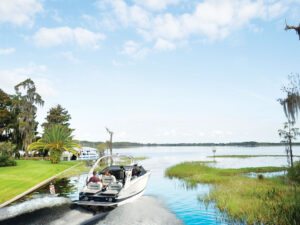Joystick docking controls are making docking as easy as playing a video game. Just push the stick sideways and you can moonwalk a boat sideways toward the dock. That’s great, if you have a 35-foot cruiser with the upgraded drive units. Driving anything smaller—or a single screw craft, takes a little more finesse. The secret to “parallel parking” in a tight space is in knowing where to attach that first line.
Toss a bow line to the dock and begin pulling — or putting reverse engine power against the line, and the front end of your boat will swing around. Ditto for the stern. Either scenario may bring one end of your boat closer to the dock, but may not leave you facing in the desired direction. Instead of starting at the ends, secure that line to the cleat in the middle of your boat.
Often called the spring cleat, this piece of amidships hardware is generally located near the windshield, at your boat’s center of turning. That means if you give a good tug to a line affixed to the spring cleat, the boat should move straight sideways. Even better, you can use your engine to do some of the pulling, and the boat will respond in the same way. Start by getting the line ashore, even if this means nosing in and then back out to get it there. Just make sure that first line ends up tied to your center cleat. Cleat one end of the line — dockside or aboard, depending on your crew scenario — and simply wrap the other end so that it can hold tension, but then be loosened to take up slack. Now, bump the throttle forward a bit, then back. Each time you “rock” the boat one way or the other, the cleated line will pull you a bit toward the dock. As this happens, unwrap the loose end of the line and rewrap it to take up the slack. You’ll move steadily toward the dock with full control, and no chance of a dock-thumping swing of the bow or stern.
Things to Remember
- Forget polypropylene and other materials. Nylon is the best material for dock lines, due to its forgiving stretch.
- Braided lines cost more than twisted lines, but they’re easier on the hands, resist kinking and are more supple for knot tying. It’s worth a few extra dollars.
- As a rule of thumb, the length of bow and stern lines should be at least two-thirds the length of your boat, while spring (amidships) lines need to be a bit longer.
- For boats in the 20- to 30-foot range, half-inch line is usually adequate.









